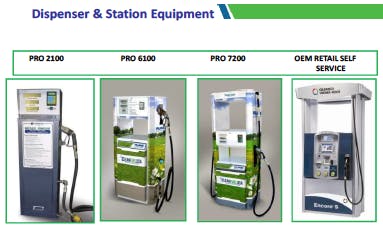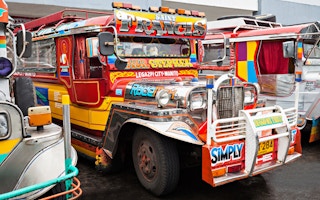The jeepney is an ubiquitous sight in the Philippines, known for its bright colours and historical significance - but also for its pollution.
To continue reading, subscribe to Eco‑Business.
There's something for everyone. We offer a range of subscription plans.
- Access our stories and receive our Insights Weekly newsletter with the free EB Member plan.
- Unlock unlimited access to our content and archive with EB Circle.
- Publish your content with EB Premium.
CleanAir Transport Solutions (CATS), a Singapore-based alternative fuels firm, has made it its mission to green the nation’s entire jeepney fleet by replacing these diesel-running vehicles with LPG-powered ones within six years.
The goal is to achieve “cleaner air for a healthier future”, while making a profit for both the business and the poor drivers who run the public vehicles, said Robin Hughes, the British chief executive officer of CATS.
The company, established in May last year and which will operate a Manila office soon, is mainly focused in the transport sector. It has been in the business for 15 years under its previous name, EcoGenTech. Hughes and his team have a combined experience in eco-entrepreneurship and start-ups, clean technology investments, alternative fuel infrastructure equipment manufacturing and renewable energy.
They have supplied their technology and know-how to various countries, such as in the United Kingdom and to General Motors (for the conversion of their pickup trucks’ engines in Thailand), noted Hughes.
Representing CATS, he is also one of over 500 organisations and individuals undersigned in the Warsaw Statement on Low Carbon Transport and Sustainable Development, a document supporting the commitment to clean mobility presented at the global climate change conference last November.
CleanAir Transport Solutions specialises in “making money by answering a difficult social question”, Hughes said.
“We think of a problem, we identify it, we quantify it, we then think of whatever solutions we can find, and when we find the solution that works commercially for us and the problem, we then find stakeholders to work with us to execute.”
So after four years of research, they have developed a new jeepney and business model that will help jeepney drivers and private owners (locally referred to as operators), the Philippine government and the general public, he explained during a recent full-day seminar and dialogue with various organisations, such as the National Federation of Transport Cooperative (NFTC), the Passenger Accident Management and Insurance Agency (PAMI), and the Environment Management Bureau (EMB) of the Department of Environment and Natural Resources (DENR) at Casino Filipino in Greenhills.
Benefits for drivers and operators
The firm’s plan is to completely scrap all existing public utility jeepneys (PUJs) and replace it with new models – of which there are seven to cater to different requirements in other parts of the country – as well as provide the supporting system of LPG fuelling stations and, possibly, repair hubs of spare parts and trained mechanics.

Sample of possible LPG fuelling stations. Image: CleanAir Transport Solutions
“The company is a vertically integrated business, a one-stop shop,” said Hughes. “We have vehicles, fuel systems are in-house… and we also manage our own warranties and spare parts.”
At the seminar, CATS discussed the financing, commercial benefits and timetable of the LPG jeepneys to the Manila-based drivers and operators present.
He revealed how with their LPG-based jeepneys, drivers and operators will be able to increase their income with yearly savings of about PHP 356,000 or a little over US$ 7,900. They spend less on LPG, which costs PHP 33 per litre (based on a six-month average), compared to diesel, which is higher by 10 pesos. The new engines also consume less fuel with LPG, and maintenance costs are significantly lower.
“With the savings from converting to LPG, in price difference and fuel efficiency, the driver can now afford to pay the rent or balance fee of the jeepney, and at the same time, they will have extra income,” said Hughes.
Drivers wouldn’t have to use the income they get from the fares as well, whether these stay at current levels or not, he noted.
CATS has also devised a financing scheme in which the value of the jeepney scrap – approximately PHP 40,000 – will be earmarked as the deposit for the new vehicle. The firm has also enlisted the help of PAMI and the Development Bank of the Philippines to get their perspectives and develop suitable insurance and financing proposals.
Currently, CATS and its partners, plus potential family offices in Australia, will secure the financing for the jeepneys, Hughes noted, while drivers and operators will get a bank loan with a repayment period of about up to five years.
Interest rates will be low, he assured. And the vehicle and the franchise from the Land Transportation Franchising and Regulatory Board (LTFRB) – the government body issuing permits for public transport operations and routes – will be used as security for the loan.
CleanAir Transport Solutions said the business model will be pocket-friendly for the drivers, since they want to see this project implemented nationwide within six years to also achieve their other goal of reducing air pollution in the Philippines.
Cleaner air for cities
The Philippines, along with Indonesia and China, is one of the most heavily polluted countries in the region. Manila, particularly, has the worst concentrated air pollution in Asia, along with Beijing, Hughes observed. Because of these conditions, the firm chose to focus on the Philippines, in addition to it having a high English literacy rate and “a willingness to do something”, he added.
It is also easier to implement a sustainable transport solution since they can overhaul only one vehicle – the jeepney – and scale it to the existing 400,000 such transportation plying the country’s streets.
Current Philippine jeepneys run on old, inefficient diesel engines, which are battered with use every day. The jeepney traces its roots back to the original jeep American soldiers had in the country during World War II in the 1940s, and there has hardly been any upgrade or innovation with this form of transport since then, Hughes said.
“
With the savings from converting to LPG, in price difference and fuel efficiency, the driver can now afford to pay the rent or balance fee of the jeepney, and at the same time, they will have extra income.
Robin Hughes, CleanAir Transport Solutions CEO
Glynda Bathan, deputy executive director of Clean Air Asia, a regional non-profit for better air quality established by the Asian Development Bank, the World Bank and the US Agency for International Development (USAID), said that as part of the public transit in the Philippines, which 80 per cent of the population uses (along with buses, trains, taxis and motorized tricycles), the jeepney plays a big role in the economy by bringing people and goods to their places of destination. It also contributes to the rising transport emissions.
According to the 2012 Clean Air Asia Annual Report, the road transport carbon dioxide emissions in developing Asia has been growing at an average rate of 10 per cent every year between 2002 to 2010.
She noted that government or independent organisation funding have so far mostly been for other modes of transport, such as the electric tricycle or public buses. The jeepney segment of the Philippines’ public transport system has largely been neglected. And this has to change, especially with the string of natural disasters that have affected the country like Typhoon Ondoy and Yolanda (Ketsena and Haiyan, internationally), which are said to be the effects of global warming, said Vicente Balao, general manager of the NFTC, a coalition of jeepney owners.
He welcomed the new initiative by CATS as it will help them in their efforts to reduce transport emissions and air pollution.
According to Hughes, LPG or liquefied petroleum gas is refined fuel from oil, a mix of propane and butane. It is 100 per cent burnable and emits significantly less carbon emissions than traditional diesel. There is also no smoke emitted from the tailpipe, he added.
Hughes pointed out that LPG has been used in Europe and South America for over 20 years. There are also more than 90 countries with fleets of taxis, buses and even private cars, running on LPG. In Asia, Thailand has about 90,000 LPG-powered taxis and tuk-tuks and Hong Kong has 45,000 taxis on LPGs, he cited.
According to the European LPG Association, LPG-fuelled vehicles emit 99 per cent less particle emissions than those running on diesel. While for nitrogen oxide (NOx) emissions, “vehicles running on LPG were 120 to 180 per cent better than petrol and 2000 per cent better than diesel, in other words, one diesel vehicle emits the same quantities of NOx as over 20 LPG vehicles”.
Compared to other alternative fuels like compressed natural gas (CNG), or the use of electric power, these energy sources are costlier and for CNG, it is more expensive to store and maintain, Hughes noted. Using solar-powered jeepneys will also will be problematic for the Philippines since it is “short on electricity”. He told Eco-Business, though, that he would welcome such entries and competition in the market.
Aside from emissions reduction, using LPGs as an alternative fuel also helps improve the health of drivers and the commuting public. In mid-2012, the International Agency for Research on Cancer, under the World Health Organization, classified diesel engine exhaust as carcinogenic to humans, such that exposure is associated with an increased risk for lung cancer, Bathan told Eco-Business.
Another advantage of the LPG jeepney programme is the boost it provides in enforcing government regulations. Part of the Clean Air Act now is implementing the Euro 4 fuel standard as the norm in the Philippines, which means the sulphur limit is 50 ppm unlike the previous Euro 2 standard followed that has a 500-ppm limit. And by 2016 all new light-duty vehicles in the country must meet the Euro 4 level. The LPG jeepney is compliant to this standard, Hughes noted.
“Right now, the jeepneys are at Euro minus-50, maybe more. They wouldn’t even be on the scale,” Hughes emphasised.
CATS is set to showcase the first vehicles in February and conduct interviews and further market research studies, while the concrete proposal is being finalised.








